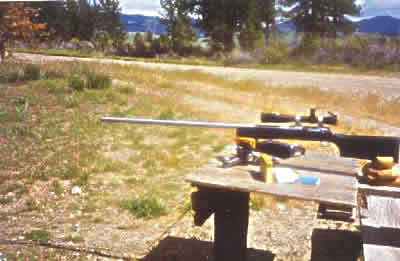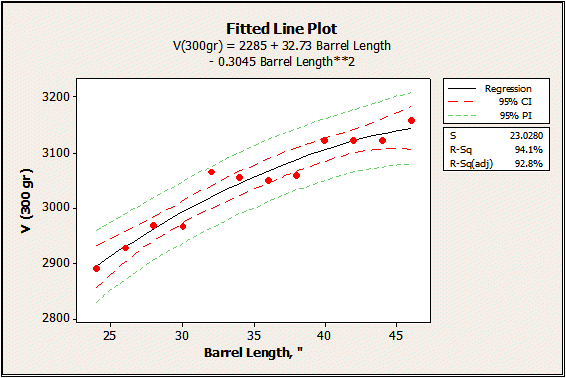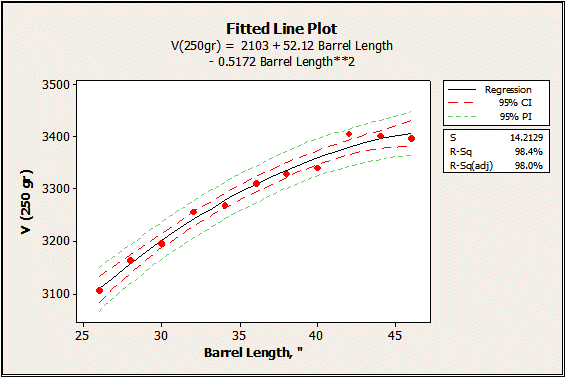Barrel Lengths in the 338/378 Weatherby Magnum
January 23, 2015 2:47 amA few years ago we made some additions to our barrel making machinery that allowed us to make barrels in some calibers and twists with finish lengths of up to 46 inches. One of the first calibers we added in these extra-long barrels was the .338 and in a 10″ twist rate. During the initial testing of these long barrels, I made up a 46″ long .338 barrel and fit it up for my Geske action and chambered it for the .338/378 Weatherby Magnum.
I had experience with the 338/378 cartridge, having shot out several earlier barrels that were used for long-range target shooting and hunting. But these barrels had been just 30″long and I wanted to do some chronograph work with the big .338 chambered in a longer barrel. I decided that I’d make a 46″ long barrel and cut 2″ off its length at a time. I’d then chronograph it as I whittled it down. And whittle it down I did, finishing the test with a 24″ remnant.

Since I was not interested in keeping the barrel or using it for any serious accuracy work, I decided to make it out of a piece of 1.250″ diameter chrome-moly steel. We would not normally make a barrel that long out of 1.250″ steel. At that diameter and length it is just too whippy. I was to see later just how whippy it was.
Before I started my testing though, I needed to establish an ambient temperature/velocity base. I knew I would be conducting my chronographing over a period of two weeks or more, time and weather permitting. I also knew, from my other 30″ long 338/378 barrels, that with the powder I planned to use (IMR 5010), the air temperature was going to make a difference in the velocities I recorded. With a given powder charge, velocities normally follow temperature changes.
I decided to use IMR 5010 for two reasons: it is an excellent powder in the 338/378, yielding top velocities and accuracy, and I also had a good supply of it on hand. And it was from this same lot of powder that I’d shot out the earlier, 30″ long 338/378 barrels. Fortunately I had good notes on my shooting with these barrels and powder, having recorded both temperatures and velocities. The same chronograph would be used for all of the testing too, an Oehler model 33 utilizing the Sky Screen III’s.
I had velocity data for temperatures from 30 degrees F. up to 85 degrees F. with records also at 40 degrees, 50 degrees, 60 degrees and 78 degrees. At some of these temperatures I had more than one velocity noted too. All of these loads used the same powder charge, 110 grains of the same-lot IMR 5010, Federal 215 primers, Weatherby 378 magnum brass, and a 320 grain Sierra Match King bullet. (More on this bullet a little later.)
I plotted these temperature/velocity points on a graph and drew a straight line along the mean point. Doing so, I found that the velocity increased at a rate of just about 2 feet- per-second per degree of temperature change. That is to say that for every increase in temperature of one degree, the velocity increased 2 feet-per-second. This was important to know because during my long-barrel experimenting the temperatures ranged from a low of 60 degrees to a high of 89 degrees. This is Montana during June. I needed to be able to correct my recorded velocities to a “Standard” temperature. I chose 73 degrees as my “Standard” because during exactly half of my shooting sessions the temperature was within 2 degrees, above or below 73 degrees. So I adjusted my velocities to this temperature. If for example I recorded a velocity at 70 degrees, I would add 6 fps ((73-70) * 2 fps = 6). I’m including a copy of my graph with the raw numbers on it, leaving it to the reader’s interpretation. It can be found at the end of this article.
I mentioned already one of the bullets I planned to use in my testing, the 320 grain Sierra Match King. This bullet was the predecessor to the currently available 300 grain Sierra Match King. I used the 300 grain version too, as well as the 250 grain Sierra Game King. So my tests included the 320, 300, and 250 grain .388 caliber Sierra bullets.
During the actual shooting I recorded and used the average velocity for 10 shots at each barrel length with the 300 grain Sierra bullet. But with the 320 grain and 250 grain bullets I recorded the average for 5 shots each. With the 250’s and 320’s I stopped the testing with a 26″ barrel length but went to 24″ with the 300 grain example.
The actual shooting was a lot of fun. I’d run out to the range with my big Geske 338/378, Oehler chronograph, sand bags, and a box of oversized cartridges rubber banded together. I’d shoot my 20 shots downrange and head back to the shop. While the barrel was still long, and because I wasn’t concerned with accuracy, I could unbolt the action from the big Six Enterprises stock, pull off the scope, leave the barrel screwed into the action, and put the barrel into the bandsaw lopping off 2 inches. I’d then put the barrel, still attached to the action, through the headstock of my Nardini 14×40 lathe, and face-off the saw cut. All I had to do then was bolt the action back into the stock, put the scope on and I was ready to go. Going from 46″ to 24″ in 2″ increments took 12 shooting sessions over about 2 1/2 weeks.

At the beginning I mentioned that the barrel was whippy at the longer lengths. The photograph accompanying this article shows the Geske actioned rifle with the barrel at its full 46″ length. When I shot it at this length, for a moment I could actually see the barrel whip like a fly rod during recoil. Obviously the waves were not very tall, but I could see them. This phenomenon displayed itself only at this longest length. With the barrel chopped to 44″ the whipping was not noticeable to my eye. Surprisingly at these long lengths the accuracy was about an inch for each group.
So, what did I find? I’ve included a chart listing the actual velocities and the velocities adjusted for temperature for each bullet and barrel length. In looking at this, the reader can make his own interpretations.
To summarize my conclusions I found that with this big cartridge, using IMR 5010 powder, the 250 grain bullet peaked out in velocity at a length of 42″. Beyond this length the bullet actually lost a little velocity. Going from 42″ to 30″ the velocity change averaged about 18 fps per inch of barrel length. From 30″ to 26″ the velocity change was greater at about 23 fps per inch.
The 300 grain Sierra continued to gain velocity all the way out to the full 46″ length where it peaked at 3159 fps. The average change per inch with this bullet was 12 fps per inch from 46″ to 30″, and from 30″ to 24″ it was almost the same at 13 fps per inch. With big case capacities, heavy bullets and slow powders, long barrels produce top velocities.
I didn’t record velocities with all barrel lengths using the 320 grain Sierra, but the average drop in velocity going from 46″ to 26″ was just over 10 fps per inch.
From this data we can draw a few conclusions. For lighter weight, walk-around-type hunting rifles chambered for big cartridges like the 338/378 Weatherby magnum, extra- long barrels are not going to gain any significant velocity increases. As I found out too, long skinny barrels are whippy, especially with the high recoil cartridges and loads. My recommendation is to use no longer than a 30″ barrel with a minimum barrel contour of a #4. A better choice would be a fluted #5 or #6 contour. Barrels over 30″ are going to have to be heavier to counter the “fly rod-phenonomen” and will probably be too heavy for most walk-around-type rifles. Or rather, too heavy for the gun bearers.
But for the serious long-range target shooter and hunter desiring the ultimate in down- range accuracy and flat-shooting trajectories, the extra velocity gained from these over30″ barrels may be well worth it. The Geske actioned rifle I used to conduct these tests now has a 40″ long 338/416 Rigby barrel screwed into it. Using the 300 grain Sierra Match King and WC872 powder, I can drive the .800 ballistic coefficient Sierra at over3200 fps. That combination offers some extremely impressive down-range energies and trajectories. And perhaps more importantly, it drifts less in the wind.
As an example of the type of down-range ballistic improvements 200 fps makes with a high ballistic coefficient bullet, we’ll compare the velocities, bullet drop, energy levels and wind drift for the 300 grain Sierra. Using the Tioga Engineering ballistics program we’ll start the big Sierra at 3000 fps and 3200 fps and compare the already mentioned values at 1000 yards, 1500 yards and 2000 yards.
300 grain Sierra Match King, C1 BC = .800, 100 yard zero, sea-level atmosphere muzzle velocity of 3000 fps
| Range yards | Velocity fps | Drop inches | Energy ft.lbs | Wind Drift inches |
| 1000 yds | 1929 | -222.9 | 2477 | 43.55 |
| 1500 yds | 1501 | -649.2 | 1500 | 110.97 |
| 2000 yds | 1182 | -1481.7 | 930 | 222.5 |
Muzzle velocity of 3200 fps
| Range yards | Velocity fps | Drop inches | Energy ft.lbs | Wind Drift inches |
| 1000 yds | 2083 | -192.5 | 2891 | 39.89 |
| 1500 yds | 1630 | -559.5 | 1769 | 101.04 |
| 2000 yds | 1270 | -1269.3 | 1073 | 202.64 |
Since long-range shooters always dial in elevation adjustments into their scope, actual bullet drop figures are not as significant as improvements in wind drift. Note that the extra 200 fps muzzle velocity translates into about a 10% reduction in wind drift. And for the long-range big game hunter, increased energy is always important too. The higher velocity increases down-range energy levels by about 15%. The big Sierra will stay supersonic farther out, too, when started at the higher velocity. The distance where a bullet becomes subsonic is its maximum effective range.
Handloaders and especially long-range shooters are always looking for higher velocities. They are always changing bullets and powders and sometimes cartridges in an effort to reach new velocity levels. Adding barrel length is one way to achieve higher velocities without increasing pressures. It is “free velocity” in the sense that there are no other changes required. Whether the benefits of a long barrel out-weigh the disadvantages depends on the type of use the rifle will see and the importance of its portability. Long barrels have their place, but it is not on every magnum rifle yet-to-be-built.
Velocities and Barrels Lengths for the 338/378 Weatherby
|
Bullet Weights Actual velocities in fps |
Bullet Weights Velocities adjusted to 73d. |
| barrel length | 250 gr | 300 gr | 320 gr | Temp F. | 250 gr | 300 gr | 320 gr |
| 46″ | 3370 fps | 3133 fps | 2930 fps | 60 º | 3396 fps | 3159 fps | 2956 fps |
| 44″ | 3402 | 3126 | 2930 | 73 | 3402 | 3122 | |
| 42″ | 3408 | 3124 | 74 | 3406 | 3122 | ||
| 40′ | 3353 | 3124 | 2957 | 79 | 3341 | 3122 | 2945 |
| 38″ | 3341 | 3071 | 79 | 3329 | 3059 | ||
| 36″ | 3326 | 3065 | 80 | 3312 | 3051 | ||
| 34″ | 3269 | 3056 | 73 | 3269 | 3056 | ||
| 32″ | 3257 | 3069 | 74 | 3255 | 3067 | ||
| 30″ | 3228 | 2999 | 89 | 3196 | 2967 | ||
| 28″ | 3177 | 2982 | 2808 | 80 | 3163 | 2968 | 2794 |
| 26″ | 3105 | 2928 | 2749 | 73 | 3105 | 2928 | 2749 |
| 24″ | 2888 | 72 | 2890 |
Notes about the above chart:
The velocities obtained were for a 10 shot average with the 300 grain Sierra bullet and 5 shot averages with both the 250 grain and 320 grain Sierras. The load was 111.5 grains of IMR 5010 loaded to an overall length of 4.135″ with the 300 grain bullet, 115.0 grains of IMR 5010 with the 250 grain Sierra and overall length of 4.050″, and 106.0 grains of IMR 5010 with the 320 grain Sierra – overall length of 4.135″. Federal 215 primers and Weatherby 378 magnum brass was used exclusively. The chronograph was an Oehler model 33 using Skyscreen III’s on a 5 foot spacing.

In June of 2004 reader Dr. Leo Rogochevski in Alberta Canada read this article and sent the following two graphs from my data along with this note about them. Thanks Leo for your insight and professional graphs. Here are his comments:
I calculated the correlation / regression between muzzle velocity and
barrel length for both (250 and 300 gr) of the bullet weights and came
up with the following equations that describe the relation
(where V, muzzle velocity, fps L, Barrel Length, “)
250 gr: V = 2100 – 52*L – 0.51*L^2
300 gr: V = 2300 – 33*L – 0.30*L^2
Because the relation is non-linear (with very tied correlation)
it means we gain only 8% of the muzzle velocity:
250 gr: V26 / V46 (Velocity ratio 26/46 “) = 0.914
300 gr: V26 / V46 (Velocity ratio 26/46 “) = 0.926
What’s the cost of it?
Here it is:
L26″ / L46″ (Barrel Length Ratio 26/46 “) = 0.565



